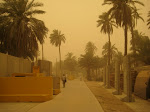
In an unexpected antithesis to my “Merry Freakin’ Christmas” post, I found Christmas Eve and Christmas Day here in the IZ to be quite pleasant and even memorable thanks, in part, to the Marine Corps major general who runs our Plans shop and our local Catholic chaplain.
On Christmas Eve afternoon, we had a Hail and Farewell, hosted by our Deputy Chief of Staff, a Marine Corps major general. We greeted new arrivals and presented end of tour awards to those who would be headed home in the next thirty days. At the end of the presentations, the general made some remarks which likened our presence together in Baghdad, a combat zone, as this year’s substitute family. He challenged us to look to each other as brothers because serving together, especially here, likened us as a family. He said we were here in Iraq at an auspicious time; the last six months have seen a remarkable down turn in ethno-sectarian violence and, unless things took a dramatic turn for the worse, we can say we were here at the turning point of this conflict. Each of us, in their own way, has contributed. To paraphrase Shakespeare’s Henry V, on the cold, rainy eve of the Battle of Agincourt, “We shall be remembered -- we few, we happy few, we band of brothers; and those at home, now-a-bed shall think themselves accursed they were not here whiles any speaks that fought with us upon this day.”
This morning, at Christmas Day mass, our Air Force chaplain similarly challenged us in his homily to reflect on the circumstances that brought us together this year. How many, he asked, could predict last Christmas, surrounded by those we love most, that we would come together from diverse countries like the United Kingdom, Italy, Kenya, Romania, and Poland, to spend Christmas together in Baghdad? We are all called by a higher purpose in our service to our respective countries be us military, civilian or contractor. This is memorable, he reminded us, and should rank with our collective set of treasured memories of Christmas. And like the spiritual promise represented by Christmas, our presence in Baghdad is the result of a promise delivered in part by all of us to make a difference here.
Merry Christmas to all.
















































